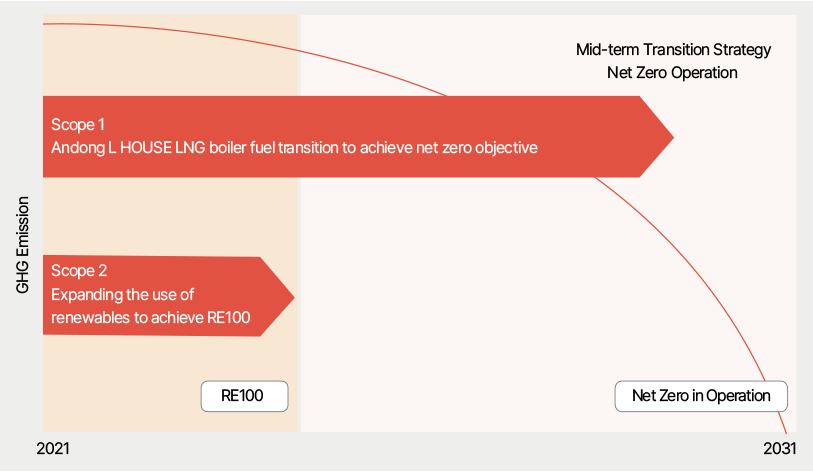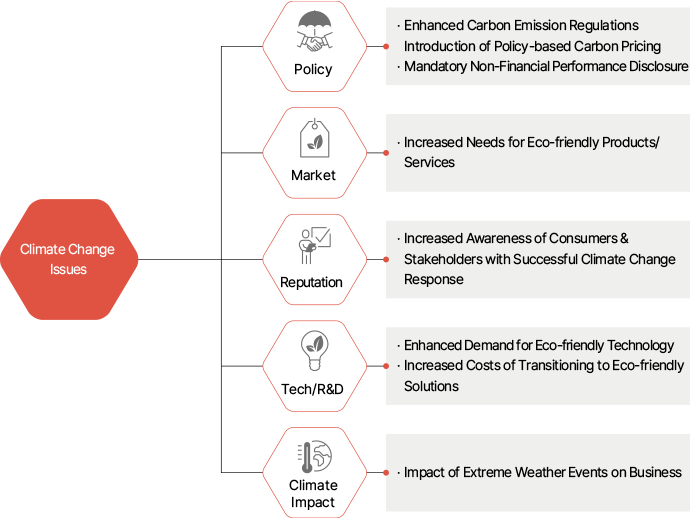Environmental
Action on Climate Change
Action on Climate Change
Governance
The Management and Supervision of the Board of Directors
SK bioscience’s key decision-making bodies, namely the Board of Directors and the ESG Committee, are responsible for issues concerning climate change response strategies and activities. The Board of Directors holds the responsibility for managing and supervising all ESG management factors, including climate change. On the other hand, the ESG Committee evaluates risks and opportunities, assesses ESG management performance, and monitors and reports the implementation progress of climate change responses to the Board. Furthermore, the Board of Directors secures climate change leadership by integrating ESG performance into the CEO’s key performance indicators(KPIs) and compensation system.
The Role of Executives
At SK bioscience, the ESG Team within the Strategic Planning Office under the CEO has established and operates a company-wide strategy to respond to climate change. Apart from overseeing the climate change response management strategy, the Strategic Planning Office makes crucial decisions regarding greenhouse gas reduction measures and investment activities. Additionally, it regularly monitors the activities of relevant departments such as their related strategies and risk management.
Climate Change Response System

Strategy
Net Zero Operation ? Short-to-mid-term Strategy to Achieve Net Zero at Business Sites
SK bioscience has set a GHG Net Zero goal and developed a roadmap in alignment with the Science Based Targets initiative(SBTi). In addition, we have identified GHG emissions by major sources at our business sites through voluntary GHG verification since 2021 and have established strategies for fuel switching and RE100 adoption to refine our Net Zero goal. At the same time, we have analyzed the economic feasibility of Net Zero costs to enhance the implementation of our strategies.
Net Zero in Value Chain ? Long-term Strategy to Respond to Climate Change
SK bioscience has completed the calculation of Scope 3 emissions for 2022 in order to plan reduction activities throughout the entire value chain. We plan to respond in stages by identifying the amount of GHG emissions in major categories. To achieve Scope 3 Net Zero, we will implement a gradual reduction strategy, starting with the conversion of internal and external vehicles to electric vehicles in the short term. Additionally, we will collect product LCA data and the emissions database of upstream and downstream transportation vehicles.
Business Site Net Zero Roadmap

Risk Management
Climate Change Risk Management System
To manage climate change risks that have a direct or indirect impact on both financial and non-financial performance, SK bioscience conducts evaluations of potential climate-related risks. These evaluations take into account the timeframe(short, medium, and long-term), financial implications, and severity of the risks. The ESG Team collaborates with relevant departments to identify and assess climate-related issues, and subsequently reports them to the management. The management incorporates the identified risks and opportunities, along with their actual and potential impact, into their decision-making processes. The risk management system reflects domestic and international climate change policy objectives, Net Zero goals, achievements, and the level of exposure to climate risks. The key findings are then reported to both the ESG Committee and the Board of Directors. Our ESG Committee is systematically monitoring climate change risks and opportunities, but moving forward, we plan to internalize climate change risk management into our Enterprise Risk Management(ERM) system, which integrates business risks for effective supervision. Accordingly, we will minimize negative risks from climate change by identifying potential impacts on the entire company in the event of severe climate change risks and proposing countermeasures.
Climate Change Risk Management Framework
-
1. Identifying Climate related Risks
- Report to the Board of Directors regarding the business and operations that involve climate risk through ESG committees
- The relevant departments and the ESG Team identify climate risks and provide reports to the Board of Directors for consideration when launching new businesses and making future investments
-
2. Evaluating Climate related Risks
- The ESG Team: Evaluating investment and business risks in consideration of the criteria for climate-related risks(scale, operation, capability, willingness to mitigate risks, etc.)
- The range of evaluation can be adjusted based on the characteristics of the biotech sector, operation, transaction characteristics, and scale, The evaluation result determines the metrics
-
3. Risk Management Activity
- The ESG Team: Reporting on risk exposure levels, metrics, and level of target achievement
- Implementing policies to manage risks by business area, collecting and analyzing data, including GHG emissions
- Disclosing climate-related risks audit conducting verification of the accuracy, clarity, comparability, and timeliness of the information
-
4. Result Reporting
- Investment and business projects with high climate risks should be approved by the CEO and involve consultation with external experts, Employees regularly review and work towards improving the management practices with project managers, aiming to transition towards a sustainable business
- Reducing manageable risk exposures of climate-related metrics, determining targets that can be improved
Identifying Climate Change Issues based on TCFD recommendations
In line with the TCFD’s recommendations, SK bioscience has identified risks and opportunities that affect the sustainability of its business and its future response to climate change. At the policy level, the strengthening of carbon emission regulations and the introduction of carbon pricing act as drivers to accelerate corporate carbon reduction efforts. Additionally, the trend of mandating non-financial performance disclosure is promoting transparent reporting of carbon reduction performance. In the market, growing demand for environmentally friendly products and services is driving a premium for low- and zero-carbon products. From a reputation perspective, we anticipate that an organization’s brand image will soon be influenced by its climate change response performance, highlighting the importance of relevant R&D and technological capabilities. We also expect that extreme weather events will impact business operations and assets.
Climate Change Factors

Climate Change Risks and Opportunities
Climate change brings about various risks and opportunities that can directly or indirectly impact our financial and non-financial performance. Recognizing the significance of climate change on our business, SK bioscience has categorized these risks into transition risks and physical risks, and conducted risk and opportunity assessments. Building upon the evaluation outcomes, we plan to consistently manage the impacts of climate change.
Transition Risks
| Risk Type | Climate Change Issues | Risks | Opportunities | Our Approach |
|---|---|---|---|---|
| Policy/Law | Introduction of carbon tax/Regulations on carbon emissions |
|
- |
|
| Increasing trend of disclosing climate change action status | - |
|
|
|
| Market | Growing global needs for sustainable life sciences |
|
|
|
| Increasing possibility of receiving negative feedback from stakeholders and rising social costs |
|
- |
|
|
| Reputation | Increasing trend of disclosing climate change action status |
|
- |
|
| Stakeholders’ perceptions of climate change response performance and communication |
|
|
|
|
| Technology | Increased demand for technologies that reduce environmental impacts and rising cost for low-carbon transition |
|
- |
|
Physical Risks
| Risk Type | Climate Change Issues | Risks | Our Approach |
|---|---|---|---|
| Acute | Heat wave |
|
|
| Wildfire |
|
|
|
| Typhoon |
|
||
| Torrential downpour |
|
||
| Chronic | Increased extreme weather events |
|
|
| Increased average temperatures |
|
|
Indicators and Goals
GHG Emissions and Net Zero Objective Response
SK bioscience aims to reduce greenhouse gas emissions by expanding the use of renewable energy through Power Purchase Agreement(PPA). By gradually reducing GHG emissions at its business sites, such as through the staged conversion of LNG fuel to hydrogen for the Andong L HOUSE multitube-through boiler, SK bioscience plans to achieve its Net Zero goal by 2031.
Net Zero Goal Response
| Unit | 2022 | 2023 | 2024 | 2025 | 2026 | 2027 | 2028 | 2029 | 2030 | 2031 | Goal | Target Year | |
|---|---|---|---|---|---|---|---|---|---|---|---|---|---|
| Percentage of LNG Boiler Fuel | % | 100 | 100 | 100 | 100 | 90 | 90 | 90 | 90 | 50 | 0 | 0% | 2031 |
| Percentage of Hydrogen Fuel | % | 0 | 0 | 0 | 0 | 20 | 20 | 30 | 30 | 50 | 100 | 100% achievement | 2031 |
| Renewable Energy Coversion Rate | % | 38 | 58 | 100 | 100 | 100 | 100 | 100 | 100 | 100 | 100 | 100% achievement | 2024 |
| Scope 1&2 Reduction Rate | % | 29 | 42 | 73 | 73 | 76 | 76 | 76 | 76 | 87 | 100 | 100% achievement | 2031 |
| Item | Goal | Target Year | |
|---|---|---|---|
| Business Site GHG Reduction | Renewable Energy Usage | 27,594 MWh | 2024 |
| Renewable Energy Usage Ratio | 100% | 2024 | |
| Scope 3 GHG Reduction | Scope 3 GHG Emissions | 11,030tCO₂eq | 2050 |
| Energy Usage | Unit | 2020 | 2021 | 2022 Goal | 2022 | 2023 Goal | |
|---|---|---|---|---|---|---|---|
| Total Energy Usage | Total Consumption | TJ | 311.9 | 347.5 | 332.9 | 383.7 | 395.2 |
Scope 3 Calculation Results and Management Plan
SK bioscience calculates and continuously manages its Scope 3 GHG emissions in order to reduce greenhouse gas emissions not only from its own business sites but also throughout the entire value chain. To calculate our Scope 3 GHG emissions, we have selected the main categories and methodologies necessary for the calculation. We have identified and collected data such as the cost and quantity of raw materials purchased, fuel usage, and emission factors. Moving forward, we will continuously manage our Scope 3 GHG emissions by improving the template and methodology for data collection and analysis. The majority of SK bioscience’s Scope 3 GHG emissions come from categories(purchased products and services) and 3(energy). Therefore, to reduce GHG emissions in both categories simultaneously, we will continue to work with key stakeholders to reduce our value chain GHG emissions, including intensively managing our partners.
Scope 3 Emission Status
| Category | Emissions(tCO2eq) | Ratio(%)(%) | |
|---|---|---|---|
| 1 | Purchased Products & Services | 77,271.60 | 69 |
| 2 | Capital Goods | 10,361.92 | 9 |
| 3 | Energy | 14,618.68 | 13 |
| 4 | Upstream Transportation | 3,008.96 | 3 |
| 5 | Waste | 746.79 | 1 |
| 6 | Business Trip | 445.22 | - |
| 7 | Commute | 821.65 | 1 |
| 8 | Lease In | - | - |
| 9 | Downstream Transportation | - | - |
| 10 | Processing | - | - |
| 11 | Product Use | 4,739.89 | 4 |
| 12 | Product Disposal | 366.10 | - |
| 13 | Lease Out | - | - |
| 14 | Franchise | - | - |
| 15 | Investment | - | - |
| Total | 112,380.81 | 100 |

